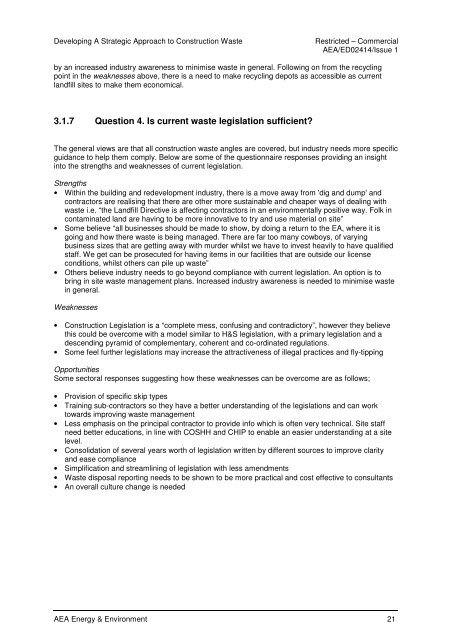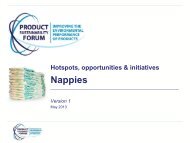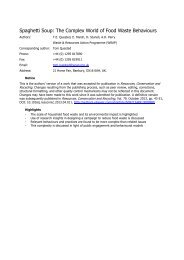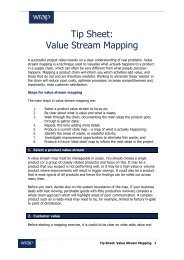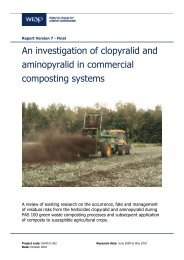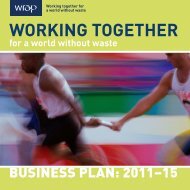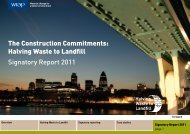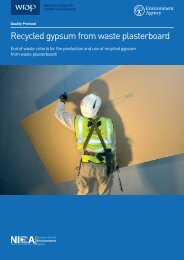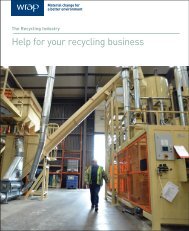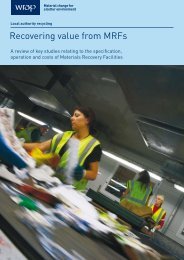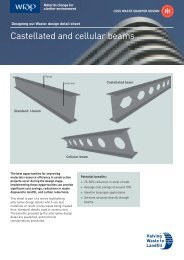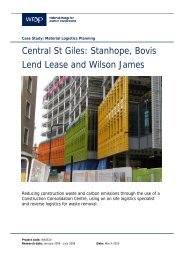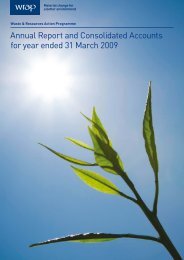Developing a Strategic Approach to Construction Waste
Developing a Strategic Approach to Construction Waste
Developing a Strategic Approach to Construction Waste
You also want an ePaper? Increase the reach of your titles
YUMPU automatically turns print PDFs into web optimized ePapers that Google loves.
<strong>Developing</strong> A <strong>Strategic</strong> <strong>Approach</strong> <strong>to</strong> <strong>Construction</strong> <strong>Waste</strong>Restricted – CommercialAEA/ED02414/Issue 1by an increased industry awareness <strong>to</strong> minimise waste in general. Following on from the recyclingpoint in the weaknesses above, there is a need <strong>to</strong> make recycling depots as accessible as currentlandfill sites <strong>to</strong> make them economical.3.1.7 Question 4. Is current waste legislation sufficient?The general views are that all construction waste angles are covered, but industry needs more specificguidance <strong>to</strong> help them comply. Below are some of the questionnaire responses providing an insightin<strong>to</strong> the strengths and weaknesses of current legislation.Strengths• Within the building and redevelopment industry, there is a move away from 'dig and dump' andcontrac<strong>to</strong>rs are realising that there are other more sustainable and cheaper ways of dealing withwaste i.e. “the Landfill Directive is affecting contrac<strong>to</strong>rs in an environmentally positive way. Folk incontaminated land are having <strong>to</strong> be more innovative <strong>to</strong> try and use material on site”• Some believe “all businesses should be made <strong>to</strong> show, by doing a return <strong>to</strong> the EA, where it isgoing and how there waste is being managed. There are far <strong>to</strong>o many cowboys, of varyingbusiness sizes that are getting away with murder whilst we have <strong>to</strong> invest heavily <strong>to</strong> have qualifiedstaff. We get can be prosecuted for having items in our facilities that are outside our licenseconditions, whilst others can pile up waste”• Others believe industry needs <strong>to</strong> go beyond compliance with current legislation. An option is <strong>to</strong>bring in site waste management plans. Increased industry awareness is needed <strong>to</strong> minimise wastein general.Weaknesses• <strong>Construction</strong> Legislation is a “complete mess, confusing and contradic<strong>to</strong>ry”, however they believethis could be overcome with a model similar <strong>to</strong> H&S legislation, with a primary legislation and adescending pyramid of complementary, coherent and co-ordinated regulations.• Some feel further legislations may increase the attractiveness of illegal practices and fly-tippingOpportunitiesSome sec<strong>to</strong>ral responses suggesting how these weaknesses can be overcome are as follows;• Provision of specific skip types• Training sub-contrac<strong>to</strong>rs so they have a better understanding of the legislations and can work<strong>to</strong>wards improving waste management• Less emphasis on the principal contrac<strong>to</strong>r <strong>to</strong> provide info which is often very technical. Site staffneed better educations, in line with COSHH and CHIP <strong>to</strong> enable an easier understanding at a sitelevel.• Consolidation of several years worth of legislation written by different sources <strong>to</strong> improve clarityand ease compliance• Simplification and streamlining of legislation with less amendments• <strong>Waste</strong> disposal reporting needs <strong>to</strong> be shown <strong>to</strong> be more practical and cost effective <strong>to</strong> consultants• An overall culture change is neededAEA Energy & Environment 21


